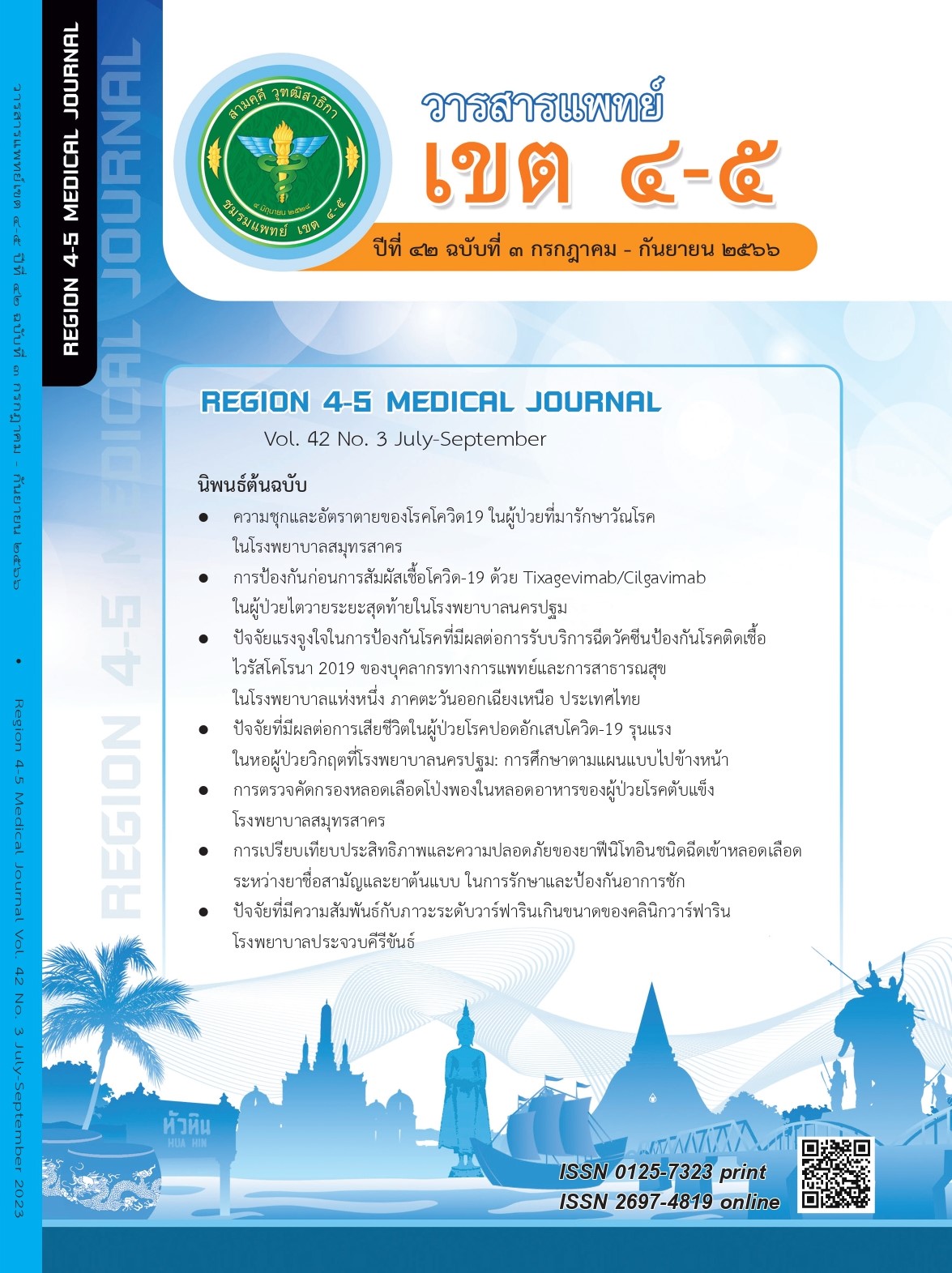ความชุกและอัตราตายของโรคโควิด19 ในผู้ป่วยที่มารักษาวัณโรคในโรงพยาบาลสมุทรสาคร
คำสำคัญ:
โรควัณโรค, โรคโควิด 19บทคัดย่อ
วัตถุประสงค์: เพื่อศึกษาความชุก และอัตราตายของโรคโควิด 19 ในผู้ป่วยโรควัณโรคที่มารักษา ในโรงพยาบาลสมุทรสาคร พ.ศ. 2564 อีกทั้งเพื่อศึกษาปัจจัยเสี่ยงและปัจจัยป้องกันเรื่องวัคซีนในผู้ป่วยโรคโควิด 19 ของผู้ป่วยโรควัณโรค
วิธีการศึกษา: เป็นการศึกษาเชิงพรรณนาแบบย้อนหลังพร้อมทั้งกำหนดช่วงเวลา (descriptive retrospective study) โดยเก็บข้อมูลย้อนหลังจากจากฐานข้อมูลผู้ป่วยวัณโรคที่มารักษาที่โรงพยาบาลสมุทรสาคร ตั้งแต่วันที่ 1 มกราคม ถึง 31 ธันวาคม พ.ศ. 2564
ผลการศึกษา: พบว่ามีผู้ป่วยที่มารักษาวัณโรค ในโรงพยาบาลสมุทรสาคร ปี พ.ศ. 2564 จำนวน 381 คน โดยตรวจพบเชื้อโควิด 19 จำนวน 49 คน (ร้อยละ 12.9) พบผู้ป่วยเสียชีวิต จำนวน 5 คน (ร้อยละ1.3)
เมื่อวิเคราะห์ข้อมูลทางสถิติ ในกลุ่มผู้ป่วยโรควัณโรคที่มีการติดเชื้อโควิด 19 พบว่า ประวัติการดื่มแอลกอฮอล์ ประวัติสูบบุหรี่ โรคความดันโลหิตสูง โรคไตเรื้อรัง และโรคเบาหวาน เป็นปัจจัยเสี่ยงในการเป็นโรคโควิด 19 ในผู้ป่วยวัณโรค (p < .01) และโรคมะเร็ง เป็นปัจจัยเสี่ยงในการเป็นโรคโควิด 19 ในผู้ป่วยวัณโรค (p < .05)
นอกจากนี้ พบว่ามีผู้ป่วยที่ไม่ได้รับการฉีดวัคซีน จำนวน 222 คน (ร้อยละ 58.3) มีการฉีดวัคซีน 2 เข็ม จำนวน 109 คน (ร้อยละ 28.6) และมีการฉีดวัคซีน 1 เข็ม จำนวน 50 คน (ร้อยละ 13.1) เมื่อวิเคราะห์ข้อมูลทางสถิติ พบว่า การไม่ได้รับวัคซีนป้องกันโรคโควิด 19 เป็นปัจจัยเสี่ยงในการเป็นโรคโควิด 19 ในผู้ป่วยวัณโรค (p < .05)
สรุป: ผู้ป่วยวัณโรค ตรวจพบการติดเชื้อโควิด 19 จำนวน 49 ราย (ร้อยละ 12.9) โดยพบผู้ป่วยเสียชีวิต จำนวน 5 ราย (ร้อยละ1.3)
เอกสารอ้างอิง
World Health Organization. Global tuberculosis report 2020. World Health Organization; 2020: 208.
Floyd K, Glaziou P, Zumla A, et al. The global tuberculosis epidermic and progress in care, prevention, and research and overview in year 3 of the end TB era. Lancet Respir Med 2018; (6)299–314. DOI: 10.1016/S2213-2600(18)30057-2.
Organiztion WH. Information note on COVID-19 and NCDs [internet]. 2020 [18 June 2021]; Available from: http://who.int/who-document-detail/covid-and-ncds.
Britto CJ BV, Lee S, Dela Cruz CS. Respiratory viral infections in Chronic Lung Diseases. Clin chest med. 2017; 38(1)87–96. DOI: 10.1016/j.ccm.2016.11.014.
de Vrieze J. Can a century-old TB vaccine steel the immune system againt the new coronavirus? [internet]. 2020 [18 June 2021]; Available from: https://www.science.org/content/article/can-century-old-tb-vaccine-steel-immune-system-against-new-coronavirus
Redelman-Sidi G. Could BCG be used to protect against COVID-19? Nat Rev Urol. 2020;17(6): 316–7. DOI: 10.1038/s41585-020-0325-9.
Sharma A, Kumar Sharma S, Shi Y, et al. BCG vaccination policy and preventive chloroquine usage: do they have an impact on COVID-9 pandemic? Cell Death Dis. 2020;11(7): 516. DOI: 10.1038/s41419-020-2720-9.
Joy M, Malavika B, Asirvatham ES, et al. Is BCG associated with reduced incidence od COVID-19? A meta-regression of global data from 160 countries. Clinical Epidemiology and Global Health. 2021;9: 202–3 DOI: 10.1016/j.cegh.2020.08.015.
Arts RJW, Moorlag S, Novakovic B, et al. BCG Vaccination Protects against Experimental Viral Infection In Humans through the Induction of Cytokines Associated with Trained Immunity. Cell Host Microbe. 2018;23(1): 89–100. DOI: 10.1016/j.chom.2017.12.010.
Bhatia V, Srivastava R, Reddy KS, et al. Ending TB in Southeast Asia. Current resources are not enough. BMJ Glob Health. 2020; DOI: 10.1136/bmjgh-2019-002073.
Sarkar S, Khanna P, Singh AK. Impact of COVID-19 In patients with concurrent co-infections. a systemic review and meta-analysis. J Med Virol 2021;93: 85–95. DOI: 10.1002/jmv.26740.
Wang Y, Feng R, Xu J, et al. An updated meta-analysis on the association between tuberculosis and COVID-19 severity and mortality. J Med Viral.2021;93(10): 5682–5686. DOI: 10.1002/jmv.27119.
Tian J, Yan S, Wang H, et al. Hanshiyi formula, a medicine for Sars-Cov2 infection in China. Reduced the proportion of mild and moderate COVID-19 patients turning to severe status: a cohort study. Pharmacal Res. 2020;161: 105127. DOI: 10.1016/j.phrs.2020.105127.
Du RH, Liang LR, Yang CQ, et al. Predictors of mortality for patients with COVID-19 pneumonia caused by sars-Cov-2: a prospective cohort study. Eur Res J. 2020;55(5). DOI: 10.1183/13993003.00524-2020.
Hu Y. Wang T, Hu Z, et al. Clinical efficacy of glucocorticoid on the treatment of patients with COVID-19 pneumonia: a single-center experience. Biomed Pharmacather. 2020;130: 110529. DOI: 10.1016/j.biopha.2020.110529.
Mo P, Xing Y, Xiao Y, et al. Clinical characteristics of refractory COVID-19 pneumonia in Wuhan; China. Clin Infect Dis 2020. DOI: 10.1093/cid/ciaa270
Rujipas S, Yupin S, Nasikarn, et al. Epidemiology, clinical characteristics, and treatment outcomes of patients with COVID-19 at Thailand’s university-based referral hospital. BMC Infectious Diseases 2021;(21): 382. DOI: 10.1186/s12879-021-06081-z.
Amir EMAMI, Fatemeh Javanmardi and Neda Pirbonyeh . Prevalence of underlying Diseases in Hospitalized Patients with COVID-19 : Systemic review and Metaanalysis. Arch Acad Emerg Med. 2020;8(1): 35. PMCID: PMC7096724.
Yadong W, Jie X, Hongjie H, et al. Prevalence od comorbid tuberculosis amongst COVID-19 patients: A rapid review and meta-analysis. Clin Pract 2021;75: 14867. DOI: 10.1111/ijcp.14867
ดาวน์โหลด
เผยแพร่แล้ว
รูปแบบการอ้างอิง
ฉบับ
ประเภทบทความ
สัญญาอนุญาต

อนุญาตภายใต้เงื่อนไข Creative Commons Attribution-NonCommercial-NoDerivatives 4.0 International License.
ลิขสิทธิ์บทความเป็นของผู้เขียนบทความ แต่หากผลงานของท่านได้รับการพิจารณาตีพิมพ์ลงวารสารแพทย์เขต 4-5 จะคงไว้ซึ่งสิทธิ์ในการตีพิมพ์ครั้งแรกด้วยเหตุที่บทความจะปรากฎในวารสารที่เข้าถึงได้ จึงอนุญาตให้นำบทความในวารสารไปใช้ประโยชน์ได้ในเชิงวิชาการโดยจำเป็นต้องมีการอ้างอิงถึงชื่อวารสารอย่างถูกต้อง แต่ไม่อนุญาตให้นำไปใช้ในเชิงพาณิชย์




